The Tree of Life, Paleontology and Evo Bio, Extinction and Rates of Evolution
1/28
There's no tags or description
Looks like no tags are added yet.
Name | Mastery | Learn | Test | Matching | Spaced |
|---|
No study sessions yet.
29 Terms
Define, recognize and describe examples of each of these terms: IDA, LUCA, ribozyme, horizontal gene transfer
Horizontal Gene Transfer: The movement of genetic material across species barriers.
LUCA: Last universal common ancestor—the most recent shared ancestor of all extant organisms. Also known as the cenancestor.
IDA: Initial Darwinian ancestor—the first living thing that is an ancestor of extant organisms; also known as the primordial form.
Ribozyme: An RNA molecule that has the ability to catalyze a chemical reaction.
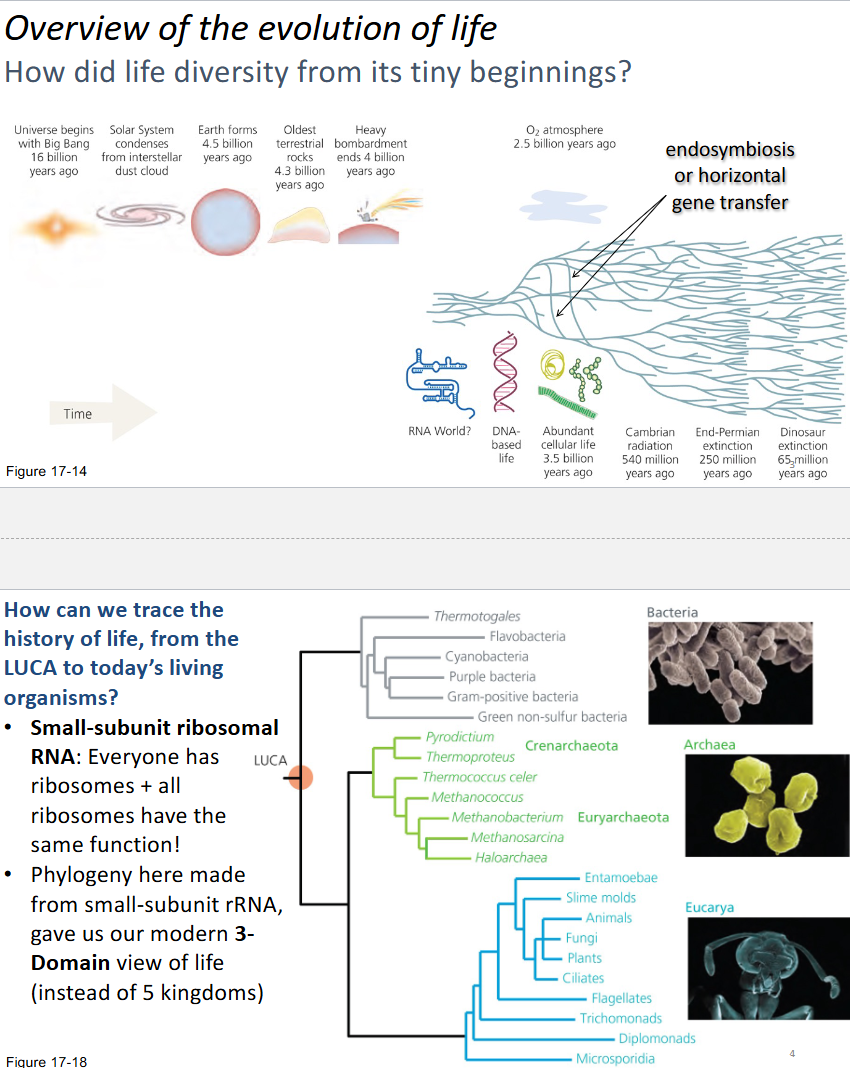
Why was the small-subunit rRNA used for the first whole-life phylogenies and what relationships did it reveal among the three domains?
All organisms have ribosomes and have similar composition and structure. Function is the same for rRNA as well: responsible for translation. The prokaryotes, for example, which are all grouped in kingdom Monera in the traditional classification, occupy two of the three main branches of the rRNA tree. One of these branches, the Bacteria, includes virtually all of the well-known prokaryotes. Because of their prokaryotic cell structure, the Archaea were originally considered bacteria. When Woese and colleagues discovered that these organisms were only distantly related to the rest of the bacteria, they renamed them the archaebacteria (Fox et al. 1977; Woese and Fox 1977). Eventually biologists realized that, as the phylogeny in Figure 17.18 shows, the archaebacteria are in fact more closely related to the eukaryotes than they are to the true bacteria. The universal rRNA phylogeny demonstrates, however, that the Animals,
Plants, and Fungi, the kingdoms that have absorbed most of the attention of evo-
lutionary biologists (and represent most of the examples in this book), are mere
twigs on the tip of one branch of the tree of life. The multicellular, macroscopic
organisms in these three kingdoms are newcomers on the evolutionary scene;
they have a relatively recent last common ancestor. For genes shared among all
organisms, such as the gene for the small-subunit rRNA, Animals, Plants, and
Fungi appear to possess less than 10% of the nucleotide-level diversity observed
on Earth

What characteristics did LUCA likely have?
LUCA’s descendants diverged to become the Bacteria on one side and the Archaea–Eucarya on the other. a DNA-dependent RNA polymerase was present in the last common ancestor. The possession of a DNA dependent RNA polymerase implies the possession of DNA (Benner et al. 1989). Likewise, DNA polymerases found in all three domains show enough similarities to suggest that the common ancestor also had a DNA polymerase. And where there was a DNA polymerase, again, there was probably DNA.
LUCA (Last Universal Common Ancestor) was a complex microbe from which all life descends. It likely had:
🧬 Genetic Features
DNA genome, used RNA and proteins
Ribosomes and the universal genetic code
L-amino acids and D-sugars
⚡ Metabolism
Anaerobic, likely lived without oxygen
Used inorganic molecules for energy (e.g. hydrogen, sulfur)
Possibly had ATP synthase and used proton gradients
🌋 Environment
Lived in hydrothermal vents
Thermophilic (heat-loving) and pressure-tolerant
🧫 Cell Structure
Had a simple membrane, possibly a lipid bilayer
Describe the four hypotheses for the origin of the three domains of life, be able to define them succinctly, and understand the evidence supporting or against them
1. Universal Gene-Exchange Pool Hypothesis: lateral gene transfer was rampant; as
independently-functioning proteins became more interdependent, modularity of
genomes was replaced by stable, integrated format in which populations started
evolving by natural selection to produce the 3 living Domains
The mechanism behind non-Darwinian communal evolution was horizontal gene transfer (HGT)—the exchange of genes between early organisms outside of reproduction. In the early gene-exchange pool, cells shared genes freely, evolving as a community rather than through individual natural selection. This collective evolution created a mosaic of genetic material, laying the groundwork for the divergence of modern domains.
2. Ring of Life Hypothesis: 1st eukaryote arose from fusion of bacterium + archean, so the phylogeny of all life has a ring at its center
In this case, metabolic genes of eukaryotes should arise from w/in alpha-
proteobacteria, but this isn’t true. No explanation of where 100s of
eukaryote-only proteins came from. Archaea & Bacteria have no cytoskeleton
– how would they have fused??
3. Chronocyte Hypothesis: Chronocyte lineage (bacteria + archaea) had a cytoskeleton and could phagocytize other microbes; ate an archean that resisted digestion to become endosymbiont, and that endosymbiont became an organelle.
Are there any living chronocytes? (No) However, there are 347 genes specific to eukaryotes including those that build the cytoskeleton, modify
RNA, and control cellular physiology – maybe inherited from chronocyte ancestor?
4. Three Viruses, Three Domains Hypothesis: Ancestors of the 3
domains of cellular life divergedwhile still carrying genetic information as RNA; each converted to DNA by 1of 3 independent viruses
Phylogeny of cellular & viral DNA-dependent RNA polymerases: Supports hypothesis that cellular genes are derived from viral genes, but also supports hypothesis that viral genes are derived from cellular genes
Phylogeny constructed using phenylalanyl-tRNA synthetase beta subunit:
Bacteria with genes closely related to Archaea show evidence of lateral gene transfer
Can you define a fossil? Describe the different types of fossils described in lecture
Fossils: Any trace of an organism that lived in the past.
How much of all of life that’s existed on earth is now extinct? What do fossils tell us?
99%.
Fossils show us phenotypes that no
longer exist in nature
Fossils tell us when groups of organisms
appeared and diversifiedFossils show us transitional features
that help us understand evolution
Taphonomy
The study of all of the things that happen between an organism’s death and it being found as a fossil
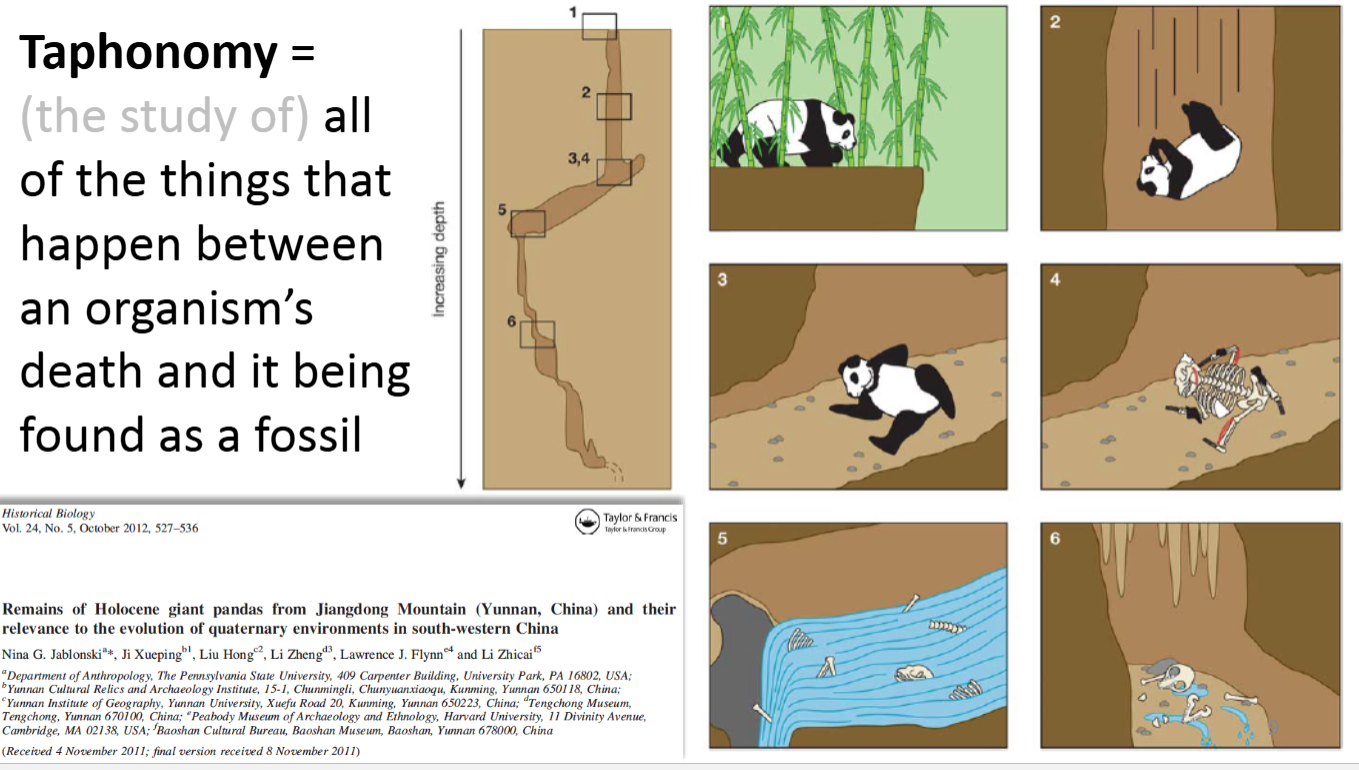
Why does the fossil record appear more complete in the northern hemisphere?
Preservation (due to taphonomy) limits what we glean from a fossil
• Plants may be permineralized, compressions, or both!
• Soft-bodied animals may have a shell, or not!
• Vertebrates may leave behind many teeth but only cartilaginous
skeletons (sharks!) or live in environments that don’t preserve bone
very well
Key reasons:
More paleontological research has historically been done in North America, Europe, and parts of Asia.
Political and economic factors have made fossil excavation and study more accessible in northern regions.
More exposed sedimentary rock in temperate northern areas makes fossils easier to find.
Colonialism and museum networks concentrated fossil collecting in the Global North.
Why do some depositional environments preserve more complete fossils than others?
Key factors:
Anoxic (low oxygen) environments—like deep lakes or ocean floors—reduce decay by limiting bacteria and scavengers.
Fine-grained sediments (like clay or silt) can gently cover organisms and preserve fine details.
Low-energy settings (e.g., lagoons, deep marine) avoid strong currents that might break or scatter remains.
Rapid burial (e.g., from volcanic ash, landslides) protects the body quickly from exposure and decay.
In contrast, high-energy or oxygen-rich environments (like rivers or deserts) often lead to fragmentation or complete decomposition
How do paleontologists find fossil localities? How do they know how old rocks are?
Old localities: Looking in the literature and going there!
• Find new localities by studying geologic maps:
How old are the rocks, and what kind of rocks are they?
🦴 How Paleontologists Find Fossil Localities:
Geological maps – They identify sedimentary rock layers of the right age and type (like shale or limestone).
Field surveys – Scientists explore exposed rock formations, especially eroded cliffs, road cuts, and badlands.
Reports and prior finds – Fossils are often found near known sites or where erosion is active.
Satellite imagery & drones – Help locate promising rock outcrops in remote areas.
⏳ How They Know the Age of Rocks:
Relative dating – Using stratigraphy: lower layers are older than upper layers.
Index fossils – Fossils of species that lived for a short time but were widespread help date rock layers.
Radiometric dating – Measures the decay of radioactive isotopes (like uranium or potassium) in volcanic ash or minerals to get an absolute age.
Magnetostratigraphy – Uses Earth’s past magnetic field reversals recorded in rocks.
Together, these methods let paleontologists find fossil-rich areas and accurately date what they uncover. Want a real-world example of how this was done?
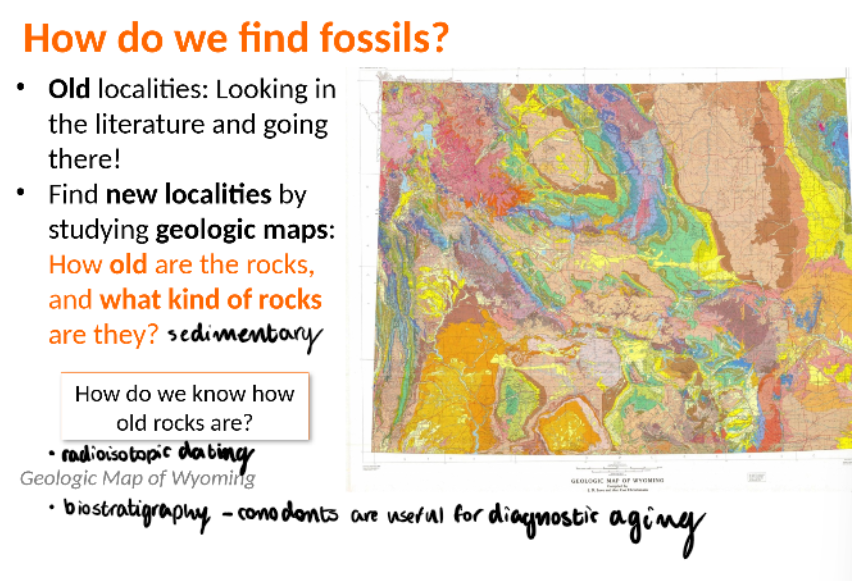
What are some common ways to prepare a fossil for study?
Cellulose acetate peel technique (mostly plants)
Thin Sections
CT Scanning
Traditional Preparation
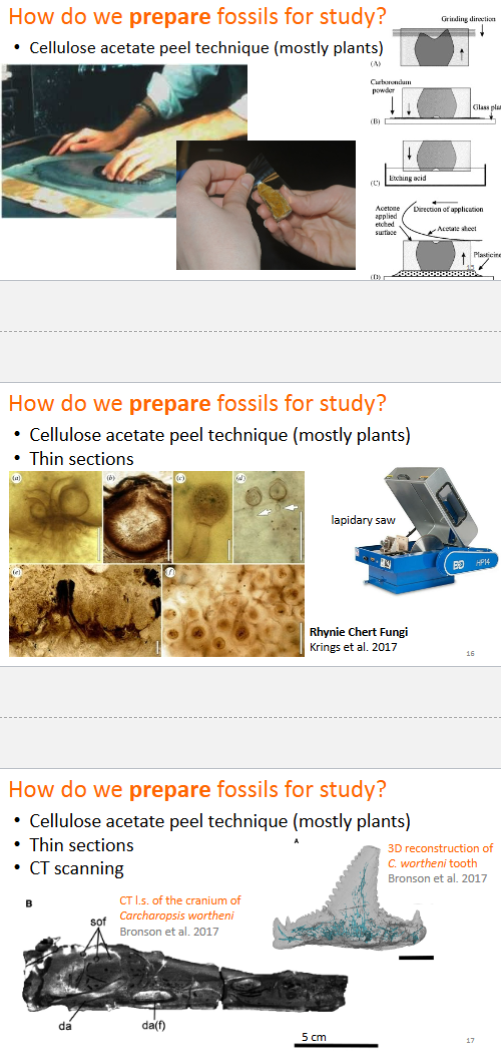
How can we differentiate the “normal” extinction rate (background extinction) from a mass extinction?
Background Extinction (96% of extinction): “Normal” extinction rate across geological history; some taxa go extinct due to evolutionary or chance events.
Mass Extinction: Is global, involves broad range of organisms, rapid relative to life span of extirpated taxa
Know the names & ages of the Big 5 mass extinction events
1. Ordovician (443 mya): 86% of animal species; glacial and interglacial episodes,
sea level rise and fall, change in atmospheric and oceanic chemistry
2. Devonian (359 mya): 75% of animal species; global climate change, anoxic
deep water spreading to shallower water, ultimately we do not know the cause
3. Permian (251 mya): 96% of animal species; Siberian volcanism and global
warming, spread of anoxic marine water, increased concentration of CO2 and
H2S, ocean acidification
4. Triassic (200 mya): 80% of animal species; Volcanic activity in Central Atlantic
Magmatic Province (CAMP) raised atmospheric CO2, increasing global
temperatures and leading to calcification crisis in oceans
5. Cretaceous (65 mya): 76% of animal species; bolide impact in Yucatan resulting
in rapid cooling, probably combined with Deccan volcanism, ultimately a shift
to global warming, eutrophication and anoxia of the oceans.
What is a lineage survivorship curve, and what’s the typical probability of extinction for a group over time?
show proportion of original sample that survives for a given time (# of species, genera,
families, etc. from an order that survived for different intervals).
Generally, probability of extinction for a particular family/genus/species is constant
over the lifespan of a given larger clade (e.g. a class or order)
What are some possible reasons for the decline in origination & extinction rates for Phanerozoic marine invertebrates?
Decline in Phanerozoic marine origination & extinction rates – Why?
• Optimization of fitness?
• Decrease in solar energy input over time?
• Decrease in amount of exposed sedimentary rock (thus biasing extinction rates)?
• Clades w/high rates of extinction/origination more likely to go extinct?
Origination and extinction rates in Phanerozoic marine invertebrates declined due to increasing ecological stability, better-adapted species, and fewer large-scale environmental disruptions. Additionally, survivorship bias and fossil record limitations may contribute to the appearance of this long-term trend.
3 Ways to Find Out How Habitat Destruction Affects extinction Rates
1. Multiply # spp. per hectare in diff. environments x rate of habitat
loss (measured via satellite photo)
2. Quantify rate that well-known spp. are moving from threatened à
endangered à extinct status
3. Estimate probability that all spp. currently listed as
threatened/endangered will truly go extinct over the next 100-200
years
What is the evidence for and against the 6th mass extinction event?
Tropical rain forests are likely
the most threatened habitat:
• Stunningly speciose: 7% of Earth’s land area, but 50% of all known plant & animal spp.
• Under acute threat of development, deforestation, and highest rate of population growth
• Many scientists believe we’re in the midst of a sixth mass extinction, based
on high extinction rates and significant habitat loss among extant taxa
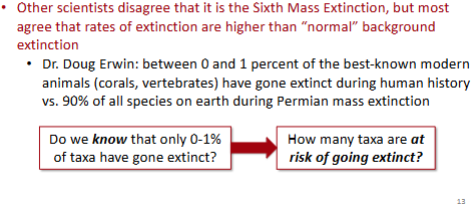
Looking at fossils in sedimentary rock can tell us when an organism lived on earth – how can we observe extinction and origination over time using both fossils and phylogenetic trees?
(2002) suggest that a decrease in the amount of exposed sedimentary rock might
introduce a bias in estimates of extinction rates. Finally, David Jablonski (2001)
suggested that the overall decline in origination and extinction rates might result
from a tendancy of clades with intrinsically high rates of both processes to go ex-
tinct during crises, whereas less volatile clades persist.
We can observe origination by identifying the first appearance of a species in the fossil record and extinction by noting its last appearance. Phylogenetic trees complement this by showing branching points (speciation events) and gaps where lineages end, helping us track how and when lineages arose or disappeared over time—even when the fossil record is incomplete.

What are the theories of Punctuated Equilibrium & Phyletic Gradualism? Is either of them “right”? Do we see a higher prevalence of either stasis or gradual change?
Punctuated Equilibrium: The hypothesis that evolution over geologic time has typically been characterized by rapid morphological change during speciation interspersed with long periods of stasis.
Phyletic Gradualism: a model of evolution where new species arise from the gradual transformation of ancestral species over long periods, with the rate of evolution relatively constant and not marked by rapid bursts or stasis
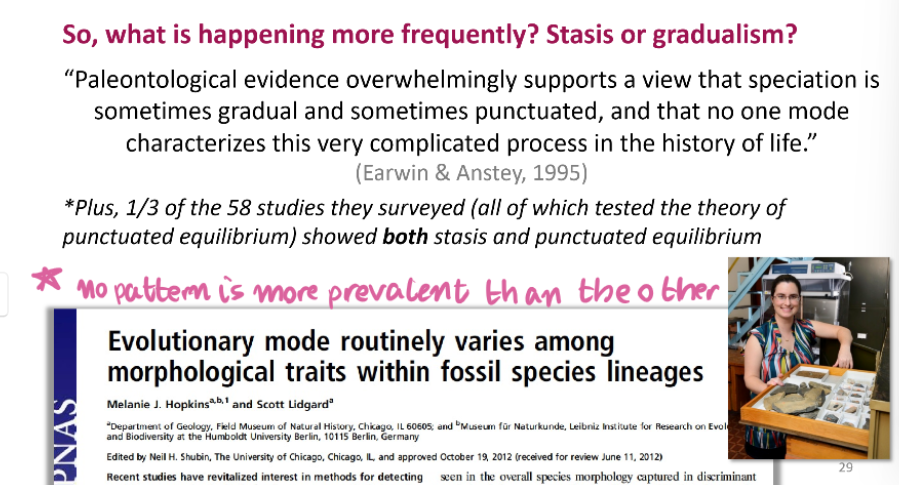
What mechanism(s) might lead to stasis in a particular clade?
It is NOT lack of genetic variation.
Stabilizing selection: individuals w/intermediate values of a trait have higher fitness, resulting in reduced phenotypic variation & potential lack of evolution in the mean value of the trait
Selection Driving towards phenotype. Selection favors intermediate.
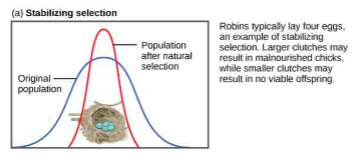
Which mechanism(s) might lead to a pattern of punctuated equilibrium? What’s the difference between competitive and noncompetitive biotic replacement?
Biotic Replacement: one clade disappears from the fossil record and another clade takes its place
Competitive: competition for resources or other biotic interactions.
Noncompetitive: Factors other than direct competition like environmental changes, shifts in niche availability or evolutionary innovations.
Adaptive Radiation: A small clade diversifies to occupy a wide variety of ecological niches ex: Cretaceous angiosperms
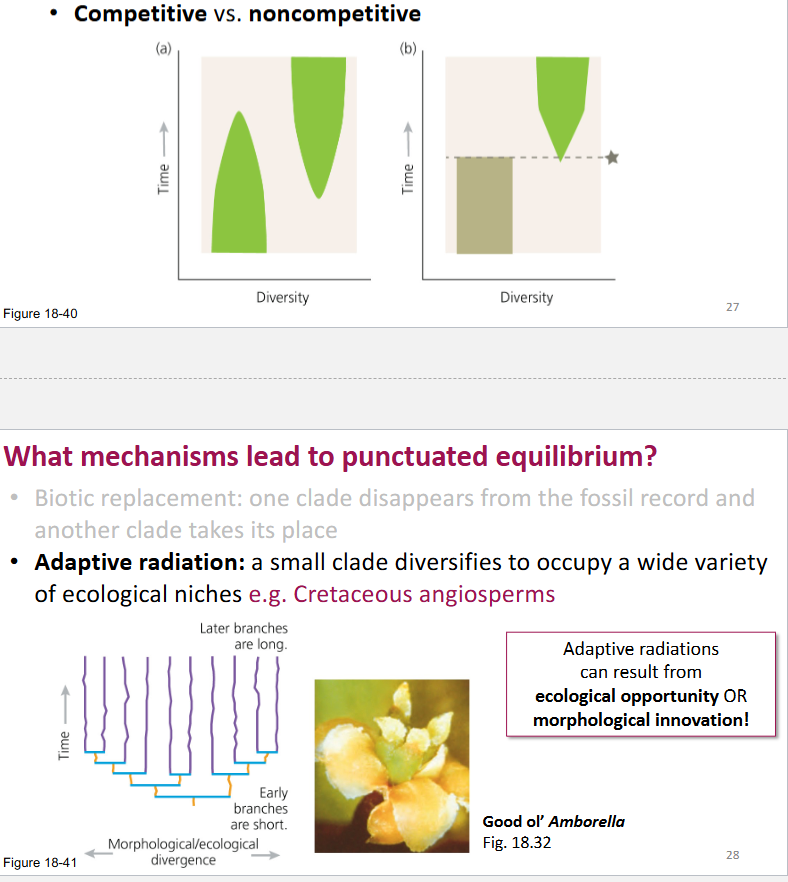
Give an example of an adaptive radiation and understand the processes that lead to an adaptive radiation
The Galapagos finches and Hawaiian Drosophilia.
Triggers:
Ecological opportunity
occurs when a small number of individuals or species are suddenly presented with a wide and abundant array of resources to exploit. Conditions favor rapid diversification and speciation.
Finches: small pop of birds happened to move from the Carribbean to the Galapagos
Diverisification at end of Cretaceous due to lack of competition.
created by dispersal and colonization or extinction of competitors.
Morphological innovation
Diversification of arthopods. Modifications and elaborations of their jointed limbs, allowed them to move efficiently and find food.
Ex: Land Plants
Radiation of terrestrial plants from aquatic in early Devonian. 400Ma.
Waxy cuticle, stomata, life history - alternating gametophyte and sporophyte generations.
Cretaceous explosion of angiosperms. 110 Ma.
Amborella - sister taxon to all other flowering plants.
250,000 species. Diverse habitats.
Efficient pollination due to flowers as a morphological innovation.
Throughout the Precambrian, Paleozoic, Mesozoic, and Cenozoic lectures, recognize instances of adaptive radiations and be able to connect these to ecological opportunity (sometimes related to extinctions) or key innovations
How can we date a phylogenetic tree? Do fossils and molecular clocks give you similar estimates? Why not?
How do we figure out when (and how fast) clades diversified?
• Molecular clocks
• Fossil calibrations
BUT BEWARE!
Molecular clock models often estimate far older divergence estimates than fossil calibrations!
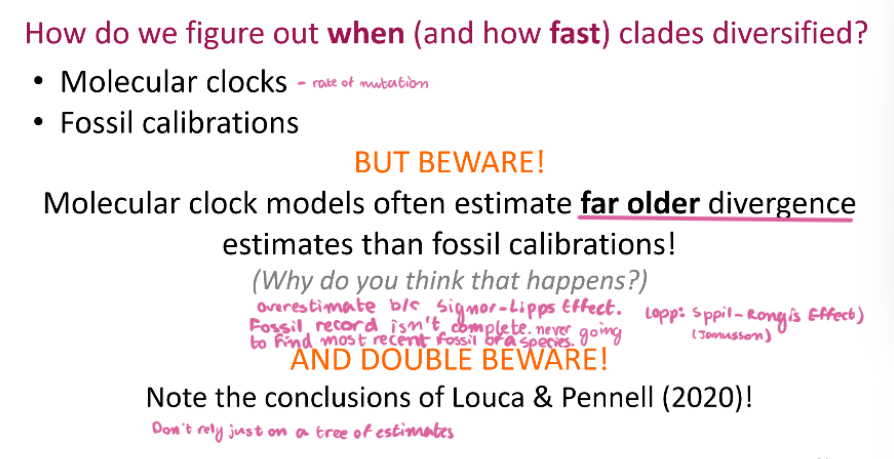
How Complete is the fossil record?
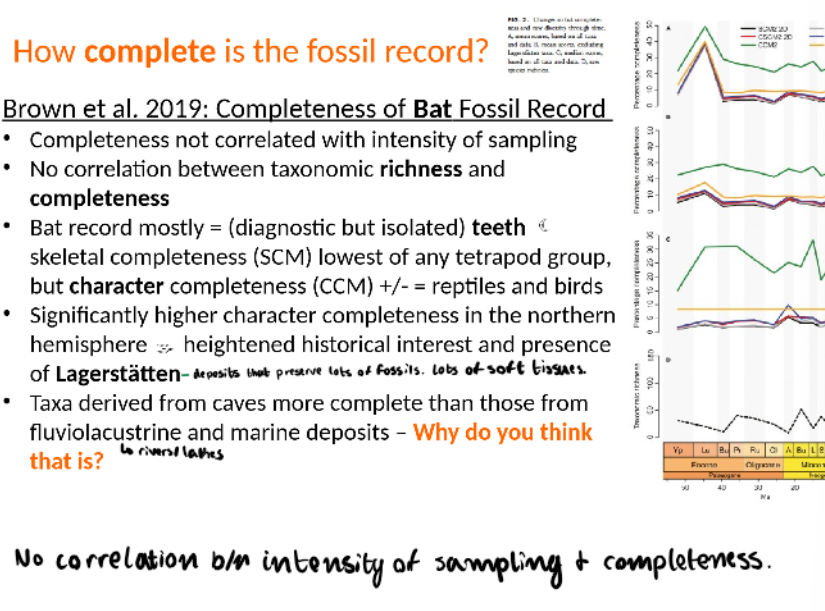
Based on the findings of Louca & Pennell (2020), what’s the risk in estimating a diversification scenario for a clade that has no fossil data?
According to Louca & Pennell (2020), the major risk in estimating a diversification scenario for a clade without fossil data is that many different birth-death (speciation-extinction) histories can produce the same phylogenetic tree of extant species. This means diversification rates are often non-identifiable from extant-only phylogenies—you can't uniquely infer how speciation and extinction changed over time without fossil evidence. As a result, any scenario you infer could be just one of many equally plausible ones.
Is there a correlation between genome size and mutation rate?
Variation in mutation rates: organisms w/larger genomes may have lower (per-basepair) mutation rates, or the opposite may be true (like in most eukaryotes)
Are mutation rates consistent over time? Is it ever advantageous to increase mutation rate?
Some mutation rates may result in higher fitness. Can vary w/in a lineage over time.
No, mutation rates are not consistent over time—they can vary between:
Species
Genomes (nuclear vs. mitochondrial DNA)
Environments
Even across different timescales within a lineage
Factors like generation time, DNA repair efficiency, and environmental stress (e.g., radiation or chemicals) can influence mutation rates.
Yes, sometimes it is advantageous to increase mutation rate, especially when:
Organisms face rapidly changing environments, like bacteria under antibiotic stress
Viruses, such as RNA viruses, benefit from high mutation rates to evade immune systems
In some cases, mutator strains arise that evolve faster, potentially gaining adaptive mutations more quickly
However, high mutation rates also increase deleterious mutations, so there's a trade-off—beneficial in the short term, but costly if unchecked.
Relaxed clock models allow for rate heterogenity